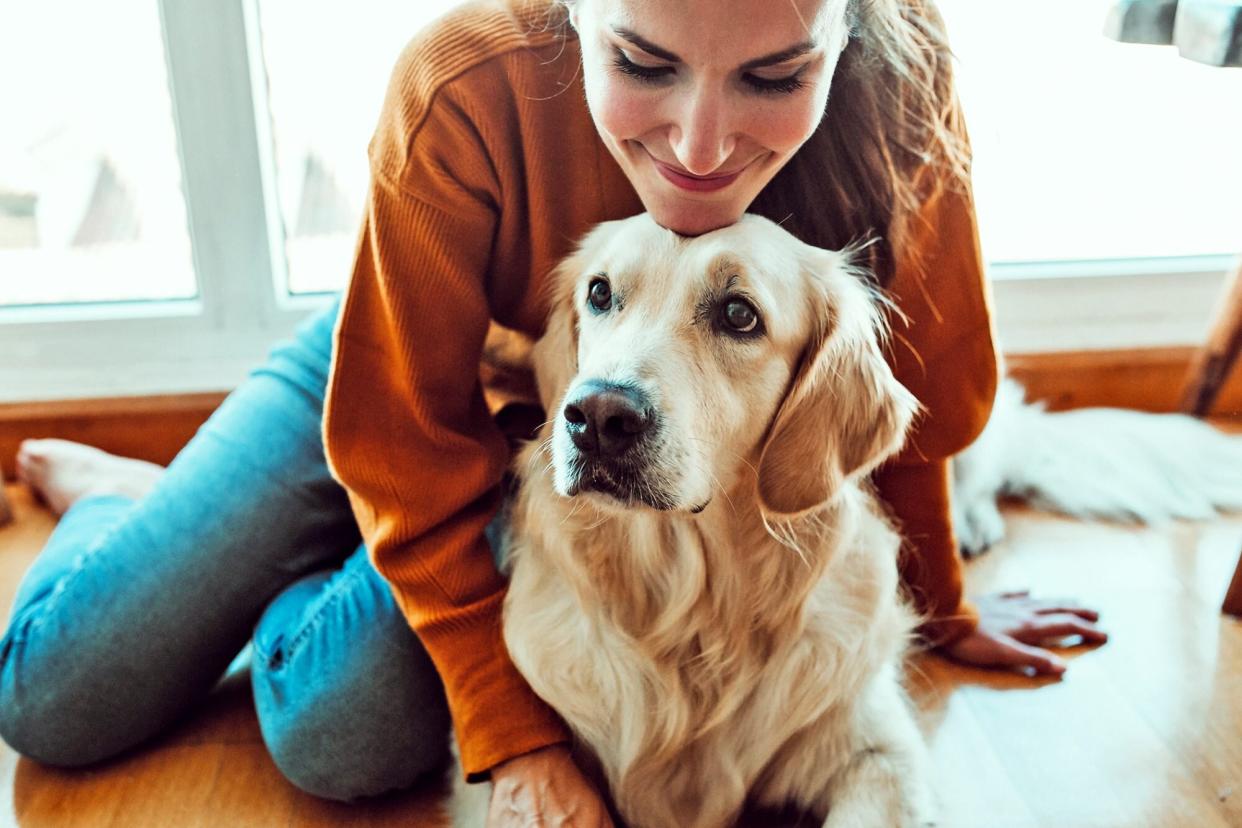Signs a Dog Is in Pain and What You Can Do to Help

Lucia Romero Herranz / EyeEm / Getty
We just can't bear to see our loving doggos suffer in any way, especially when they're hurting and we don't know why. However, the signs a dog is in pain vary greatly, and they might not always directly relate to the underlying issue.
We asked RuthAnn Lobos, DVM, CCRT, CVAT, a senior veterinarian at Purina, for some of the most common indications your pet has pain and what you can do to help.
How to Tell If a Dog Is in Pain
"Dogs can display pain in a multitude of ways and sometimes it's not as obvious as holding up their leg or paw, although limping is one of the most common signs of pain, especially if the injury is severe," Lobos says. "However, in more chronic situations, like arthritis or other conditions that involve abdominal/internal organ pain, the signs may be more subtle."
She adds that another reason why it might be hard to spot pain symptoms in dogs is because they often want to hide or isolate from the family if they're hurting.
Lobos outlines some indications your pup is suffering that require a closer look.
Physical Signs of Pain
In an acute injury or situation, you may notice:
Crying out, whining, or whimpering
Panting or rapid breathing
Increased heart rate
Excessive licking or chewing of parts of their body
"The licking may at first be helpful in soothing the pain receptors in the skin, but over time that licking can actually cause more harm as it irritates the skin and can lead to infection," Lobos says. "Chewing or biting at the area has the same purpose as licking but can certainly cause secondary negative effects more quickly."
Changes in mobility are other pain clues. For example, dogs experiencing acute abdominal discomfort due to an intestinal blockage, pancreatitis, or gastrointestinal distress may be reluctant to move and/or have a tense belly. They could also drool, demonstrate lethargy, and/or have a decreased appetite.
When a pooch suffers from chronic pain, they might display other mobility issues, such as:
Being slower to get up, especially in the mornings or after napping
A reluctance to jump up onto the couch or bed
Not moving as quickly during walks or usual runs
Developing more of a hunched stance
If a condition is less severe, like with a limb injury, Lobos says your dog might "off-load" or shift their weight to one of their other legs. While not obvious at first, this will cause the muscles of the affected limb to atrophy or shrink from disuse over time, and lead to compensatory issues and pain in other parts of their bodies. "For example, if they hurt their knee, they may start to hold the whole leg out to the side just a little," she says. "This can lead to hip pain and back pain."
RELATED: What Happens If a Dog Gets a Torn ACL? Here's What to Expect If It Happens to Your Pup
She adds that another source of pain in our pets that can be confusing is dental pain—especially in older pets. "Owners often see drooling, decreased appetite, or dropping their kibble when eating."
Behavioral Signs of Pain
Your dog's behavior might reflect the aches they feel in the following ways:
Becoming more "grumpy"
Shying away from being petted, particularly around the painful area
Carrying their tails differently, especially when they have chronic back or hip issues
Displaying restlessness
Being more clingy or following you around
Should You Give Your Dog Pain Medicine?
"Before the veterinary appointment, you may be tempted to give aspirin or other pain medicine designed for people, but those can be very dangerous for dogs and cause more health issues for them," Lobos says. This caution includes Tylenol and ibuprofen.
Instead, arrange for a thorough veterinarian exam. Then, have a discussion with your vet about what pain management treatment might be best for your pet's condition.
Diagnosing Signs of Pain in Your Dog
Because the symptoms above could indicate any number of ailments, one way to help your vet determine what's wrong with your pup is to take video or pictures of what you're seeing.
Lobos says after a detailed physical exam, your vet may want to perform a number of tests, like radiographs (or x-rays) and blood work. "These tests help your veterinarian better identify the source of the pain, and then develop a plan for treating the pain," she says. "Your general practitioner may prescribe medications, recommend a change in diet, or include supplements to help with the pain."
RELATED: Could a Dog Chiropractor Help Your Dog's Joint Pain?
She adds that some veterinarians offer services like physical rehabilitation or acupuncture that may also be appropriate for your dog. Depending on the diagnosis, your veterinarian might also refer you to a specialist, like an orthopedic surgeon, a rehabilitation specialist, or an internist.
"Open communication and trust are the most important components to the relationship you have with your veterinarian to provide the best care for your four-legged friend," Lobos says.

